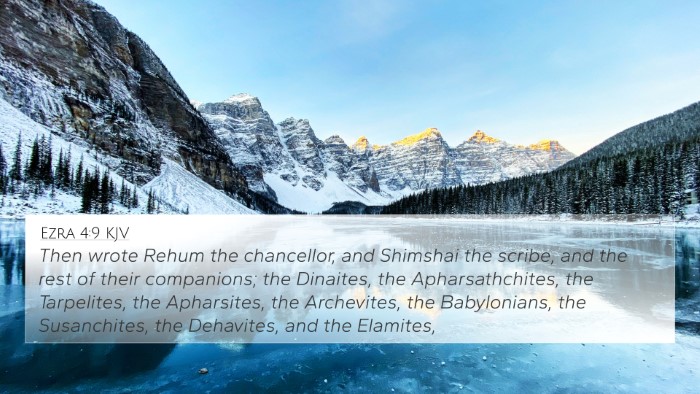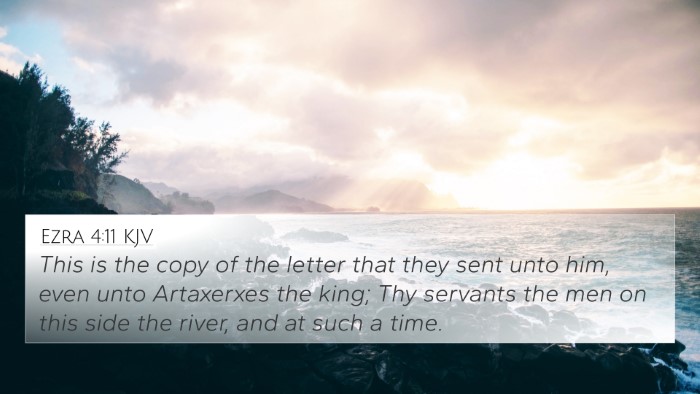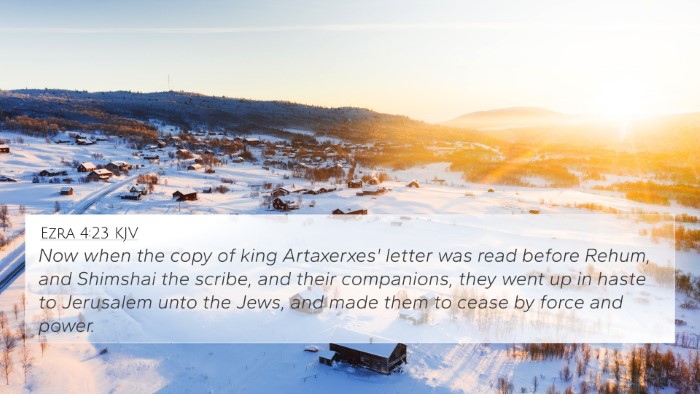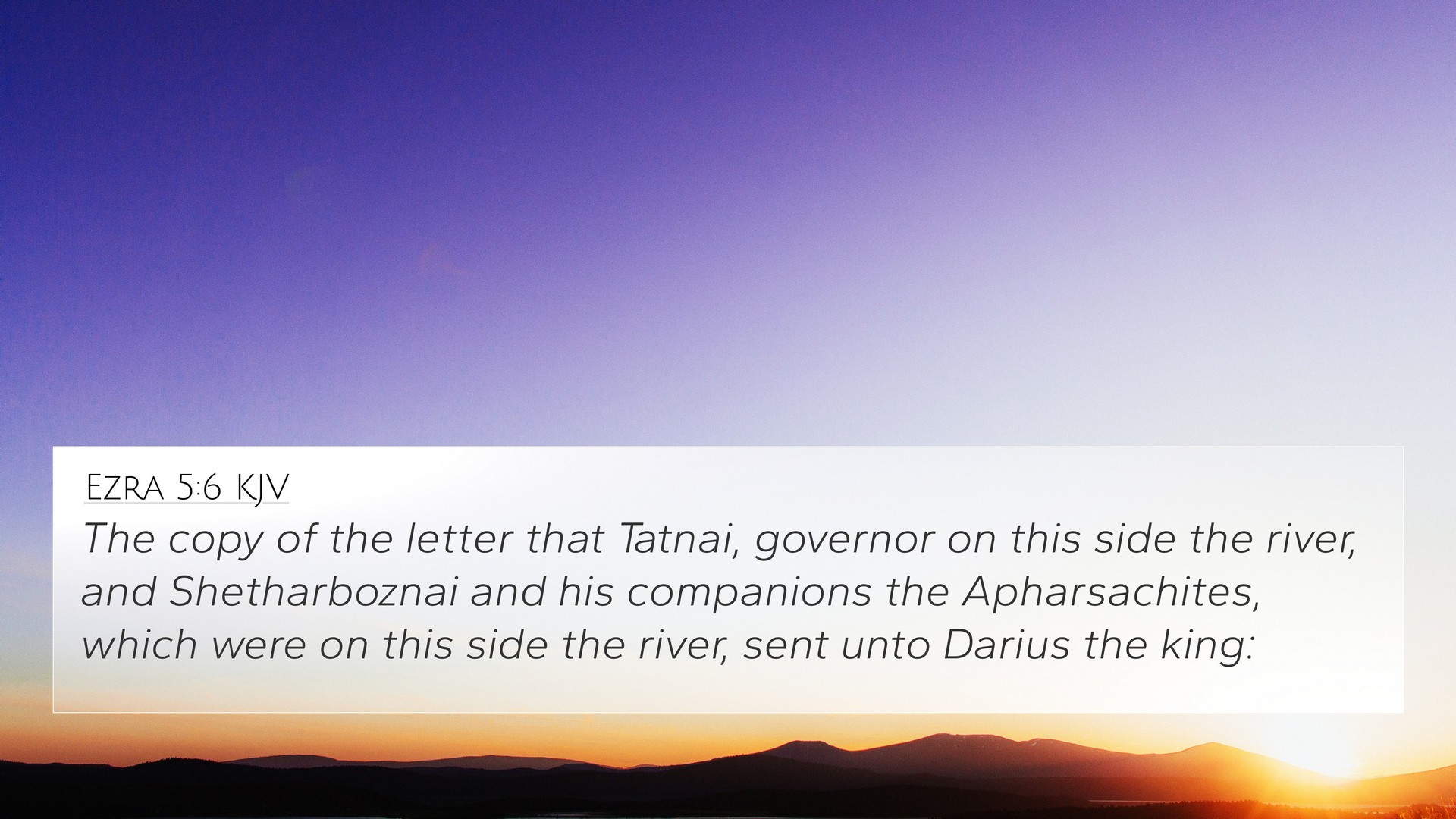Old Testament
Genesis Exodus Leviticus Numbers Deuteronomy Joshua Judges Ruth 1 Samuel 2 Samuel 1 Kings 2 Kings 1 Chronicles 2 Chronicles Ezra Nehemiah Esther Job Psalms Proverbs Ecclesiastes Song of Solomon Isaiah Jeremiah Lamentations Ezekiel Daniel Hosea Joel Amos Obadiah Jonah Micah Nahum Habakkuk Zephaniah Haggai Zechariah MalachiEzra 5:6 Similar Verses
Ezra 5:6 Cross References
The copy of the letter that Tatnai, governor on this side the river, and Shetharboznai and his companions the Apharsachites, which were on this side the river, sent unto Darius the king:
Uncover the Rich Themes and Topics of This Bible Verse
Listed below are the Bible themes associated with Ezra 5:6. We invite you to explore each theme to gain deeper insights into the Scriptures.
Ezra 5:6 Cross Reference Verses
This section features a detailed cross-reference designed to enrich your understanding of the Scriptures. Below, you will find carefully selected verses that echo the themes and teachings related to Ezra 5:6 KJV. Click on any image to explore detailed analyses of related Bible verses and uncover deeper theological insights.

Ezra 4:9 (KJV) »
Then wrote Rehum the chancellor, and Shimshai the scribe, and the rest of their companions; the Dinaites, the Apharsathchites, the Tarpelites, the Apharsites, the Archevites, the Babylonians, the Susanchites, the Dehavites, and the Elamites,

Ezra 5:3 (KJV) »
At the same time came to them Tatnai, governor on this side the river, and Shetharboznai and their companions, and said thus unto them, Who hath commanded you to build this house, and to make up this wall?

Ezra 4:11 (KJV) »
This is the copy of the letter that they sent unto him, even unto Artaxerxes the king; Thy servants the men on this side the river, and at such a time.

Ezra 4:23 (KJV) »
Now when the copy of king Artaxerxes' letter was read before Rehum, and Shimshai the scribe, and their companions, they went up in haste to Jerusalem unto the Jews, and made them to cease by force and power.

Ezra 6:6 (KJV) »
Now therefore, Tatnai, governor beyond the river, Shetharboznai, and your companions the Apharsachites, which are beyond the river, be ye far from thence:
Ezra 5:6 Verse Analysis and Similar Verses
Understanding Ezra 5:6
This section provides a detailed exploration of the meaning and interpretation of Ezra 5:6, utilizing insights from renowned public domain commentaries, including those by Matthew Henry, Albert Barnes, and Adam Clarke.
Verse Overview
Ezra 5:6 states:
"The copy of the letter that Tattenai, governor of the region beyond the River, and Shethar-bozenai, and his companions, the officials who were in the region beyond the River, sent to Darius the King."
Contextual Analysis
To understand Ezra 5:6, it is crucial to recognize the historical context in which it was written. The verse reflects the communication between Tattenai, the governor of a region under Persian control, and King Darius regarding the rebuilding of the temple in Jerusalem.
Purpose of the Letter
- Authority and Legitimacy: Tattenai seeks to establish the legitimacy of the Jewish leadership and their endeavors in rebuilding the temple.
- Clarification of Intent: The letter aims to clarify their intentions and methodologies in construction to ensure compliance with Persian law.
- Political Maneuvering: This correspondents also speaks to the political atmosphere of the time—struggles between Persian governors and local authorities.
Commentary Insights
Matthew Henry's Commentary
Matthew Henry discusses the significance of this correspondence as a demonstration of God’s providence at work during this time. He emphasizes how God uses both secular authorities and His people to fulfill His divine plan.
Albert Barnes' Notes
Albert Barnes highlights the importance of this verse as it illustrates the challenges faced by the Jews during their rebuilding efforts. He notes that the presence of officials like Tattenai signifies the scrutiny under which the Jewish community operated and reflects their resilience.
Adam Clarke's Commentary
Adam Clarke focuses on the technicalities of the law and the expectations of the Jewish people to prove their rights over Jerusalem. He refers to the ongoing dialogue between different authorities and its implications for the restoration of the Jewish state.
Related Bible Verses
Ezra 5:6 connects to several other scripture passages, highlighting thematic and linguistic parallels that enrich the understanding of God's restoration plan:
- Ezra 1:1-4: Chronicles the decree of Cyrus permitting the Jews to return and rebuild, setting a foundational tone for the events in Ezra 5.
- Ezra 3:8-11: Discusses the beginning of the temple reconstruction and the people's joy and reverence during the laying of the foundation.
- Daniel 9:25-27: Contains prophecies regarding the reconstruction of Jerusalem, offering insight into the broader covenant context.
- Nehemiah 2:5: Highlights Nehemiah’s similar plea to King Artaxerxes, illustrating the continued efforts of Jewish leaders in securing support for Jerusalem.
- Haggai 1:7-8: Encourages the people to consider their ways and rebuild the house of God, echoing the sentiments of determination seen in Ezra.
- Zechariah 1:16: Speaks of God's desire to return to Zion and dwell in Jerusalem, aligning with the themes of God's favor towards His people.
- Acts 7:46-50: Connection to the New Testament portrayal of the temple, showcasing the ongoing relevance of the Jewish heritage in early Christianity.
Applications for Cross-Referencing
This verse serves as an excellent case for cross-referencing within scripture, allowing for a deeper understanding of faith and governance. Here’s how to utilize tools for Bible cross-referencing effectively:
- Understanding Themes: By linking parallel accounts, one can better grasp the overarching themes of providence and community effort in God's plans.
- Bible Concordance: Utilize a concordance to find related texts that discuss the Jewish return and the rebuilding of the temple.
- Comparative Bible Analysis: Engage in comparative analysis of passages from the Old Testament with New Testament teachings to see how these events tie into the broader narrative of redemption.
- Cross-Referencing Methods: Implement various cross-referencing Bible study methods, which may include thematic studies, word studies, or character studies.
Concluding Thoughts
Ezra 5:6 serves as a pivotal verse that not only highlights the historical context of the Jewish return but also illustrates the dynamic tension between authority and faith. The interplay of correspondence between Tattenai and Darius shows the operational realities of God’s work among His people and across nations.
By engaging with this verse and its connections, readers are invited to explore the broader Biblical narratives through the lens of inter-Biblical dialogue and thematic connections, thereby enriching their understanding of scripture.


